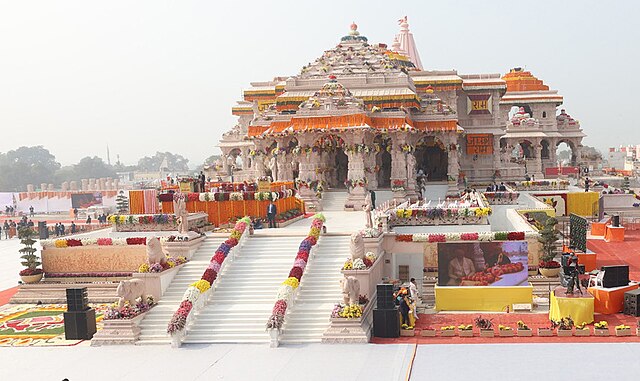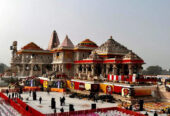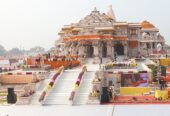Ayodhya Ram Mandir: A Revered Symbol of Faith and Heritage
The Ayodhya Ram Mandir, an iconic Hindu temple dedicated to Lord Ram, stands as a profound symbol of spiritual devotion and historical significance in India. Located in the holy city of Ayodhya, Uttar Pradesh, this temple is deeply rooted in Indian mythology and history, making it one of the most revered pilgrimage sites in the country.
Historical Context
The Ayodhya Ram Mandir’s history is intertwined with the epic Ramayana, one of the greatest Hindu epics. According to the Ramayana, Ayodhya is the birthplace of Lord Ram, the seventh avatar of Vishnu and a central figure in Hindu worship. The site has been a focal point of Hindu devotion for centuries.
The original temple dedicated to Lord Ram was believed to have been built in the 12th century. However, over the years, it faced several challenges, including destruction and rebuilding. The most significant historical event related to the temple was the demolition of the Babri Masjid, which stood on the site in 1992, leading to widespread controversy and legal battles.
In 2019, the Supreme Court of India ruled in favor of constructing a Ram Temple on the disputed site. This landmark decision paved the way for the reconstruction of the Ayodhya Ram Mandir, symbolizing a new chapter in its storied history.
Architectural Features
- Design and Structure: The Ayodhya Ram Mandir is being constructed in the Nagara architectural style, which is traditional to North Indian temples. The design incorporates elements such as intricate carvings, towering spires (Shikharas), and ornate pillars.
- Sanctum Sanctorum (Garbhagriha): The main shrine, or Garbhagriha, will house the idol of Lord Ram. This central chamber is designed to be a space of intense spiritual significance, reflecting the reverence and devotion of countless devotees.
- Mandap: The temple will feature a large Mandap (hall) where devotees can gather for prayers and religious ceremonies. The Mandap is designed to accommodate large numbers of worshippers and provide a space for community gatherings.
- Shikharas and Vimana: The temple’s architecture includes grand Shikharas (spires) and Vimana (towering structures) that rise majestically, symbolizing the divine presence and grandeur of the deity.
- Carvings and Sculptures: The temple will be adorned with intricate carvings and sculptures depicting scenes from the Ramayana and other Hindu scriptures. These artworks will enhance the temple’s spiritual ambiance and provide a visual narrative of Lord Ram’s life.
Cultural and Spiritual Significance
- Religious Importance: The Ayodhya Ram Mandir holds immense religious significance for Hindus. It is believed to be the birthplace of Lord Ram, making it a central site for worship and pilgrimage. The temple’s construction represents a long-held aspiration of millions of devotees.
- Pilgrimage Site: The temple will attract pilgrims from across India and the world, contributing to Ayodhya’s status as a major pilgrimage destination. The site is expected to become a hub of spiritual activity, hosting various religious events, festivals, and rituals.
- Historical Legacy: The temple’s reconstruction symbolizes the resolution of a historical and cultural dispute that has been at the center of India’s socio-political discourse. It represents the endurance of cultural heritage and the fulfillment of a collective aspiration.
- Community Impact: The Ayodhya Ram Mandir’s construction is expected to have a significant impact on the local community, boosting tourism, creating employment opportunities, and fostering economic development in the region.
Visitor Experience
- Temple Visit: Devotees and tourists visiting the Ayodhya Ram Mandir will experience a spiritually uplifting environment. The temple’s serene ambiance, coupled with its majestic architecture, offers a profound experience of devotion and reverence.
- Rituals and Ceremonies: Visitors can witness various rituals and ceremonies performed in the temple, including daily prayers, aartis (ritualistic offerings), and special festivals. Participating in these ceremonies allows visitors to connect with the temple’s spiritual essence.
- Exploring Ayodhya: Beyond the temple, Ayodhya offers various attractions, including ancient temples, ghats, and historical sites associated with the Ramayana. Exploring the city provides a deeper understanding of its cultural and spiritual heritage.
- Guided Tours: For those interested in learning more about the temple’s history, architecture, and significance, guided tours are available. These tours offer insights into the temple’s construction process, religious context, and the broader historical landscape.
Accessibility and Visitor Information
- Location: The Ayodhya Ram Mandir is located in Ayodhya, Uttar Pradesh, India.
- Visiting Hours: The temple will be open to visitors throughout the day, with specific timings for rituals and ceremonies. It is advisable to check for updated visiting hours and special events.
- Entry Fee: There is no entry fee to visit the Ayodhya Ram Mandir. However, donations for the temple’s upkeep and development are welcome.
- Accommodation: Ayodhya offers a range of accommodation options, including guesthouses, hotels, and lodges. Visitors can choose from various options based on their preferences and budget.
Conclusion
The Ayodhya Ram Mandir stands as a monumental symbol of faith, heritage, and cultural identity. Its construction marks a significant moment in India’s religious and historical landscape, reflecting the enduring devotion of millions of Hindus. Whether you are a devotee, a history enthusiast, or a curious traveler, a visit to the Ayodhya Ram Mandir offers a deeply enriching and spiritual experience.













Leave feedback about this